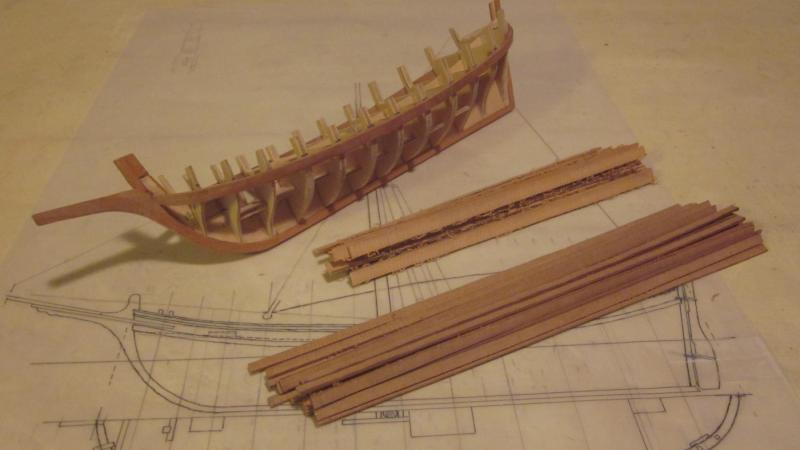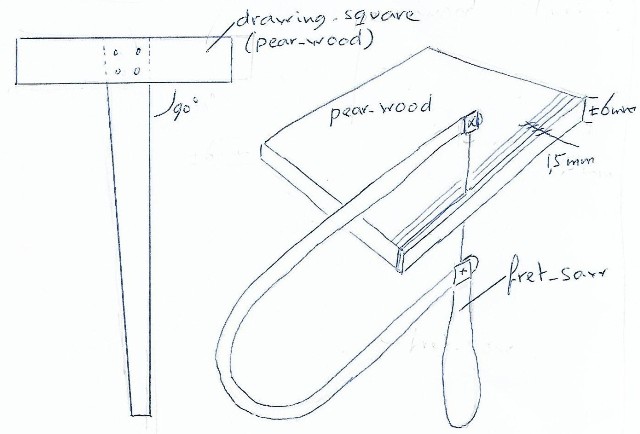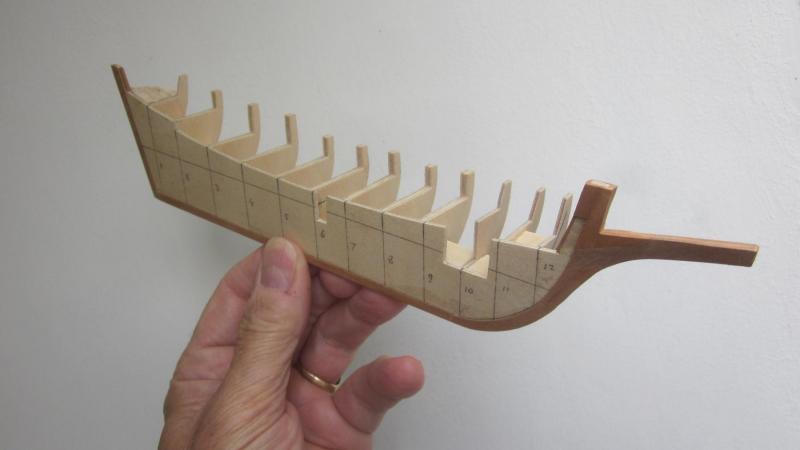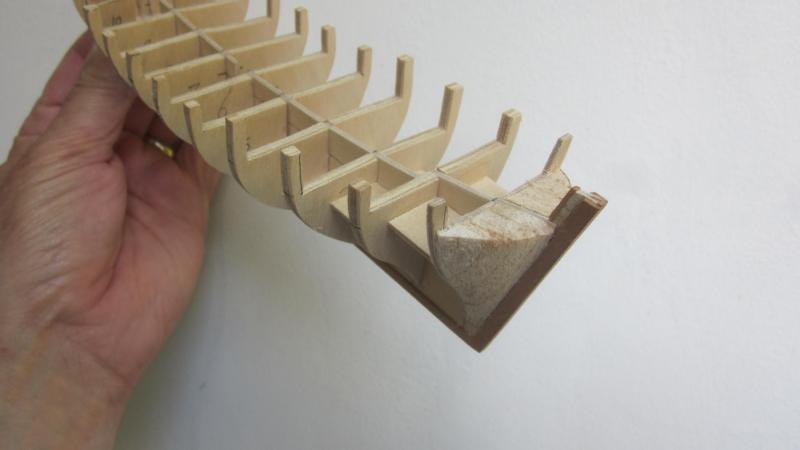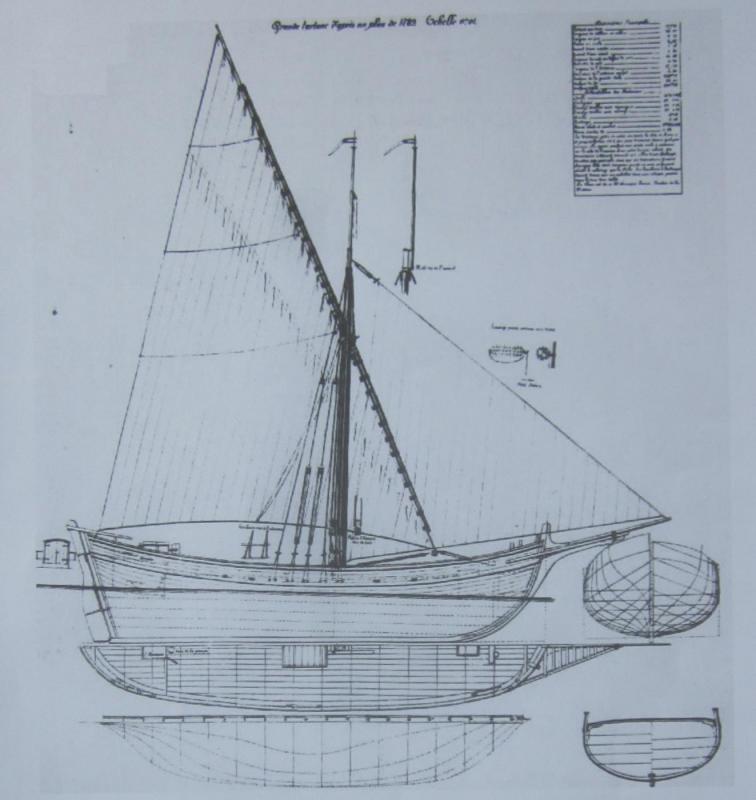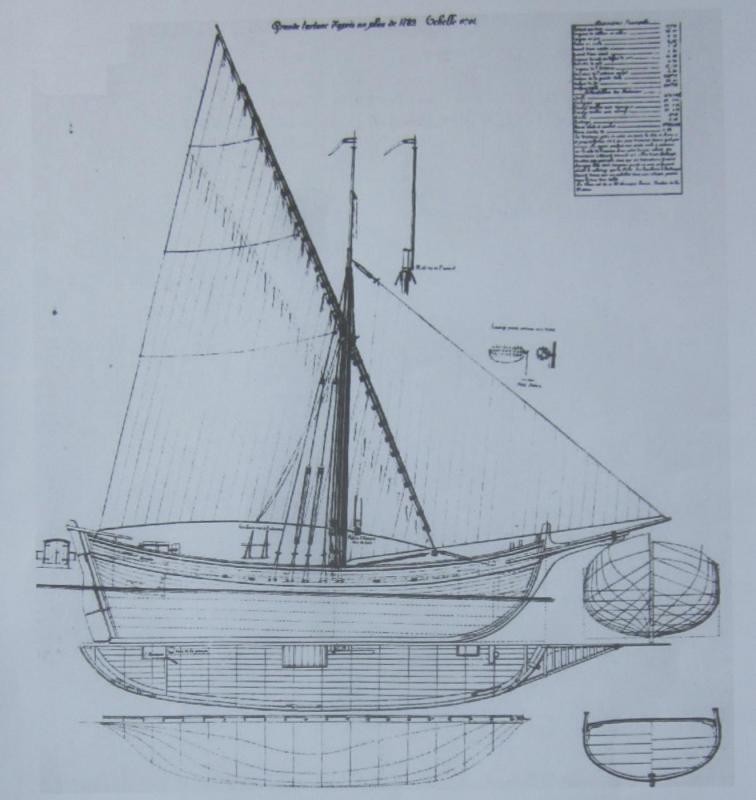
tartane
Members-
Posts
127 -
Joined
-
Last visited
Content Type
Profiles
Forums
Gallery
Events
Everything posted by tartane
-
The planks are the next parts of the model. I Always start below the rubbing strake. This is not always the correct way of building the real ship, but it works very well for me. Before attaching the planks I rubb the sides with a soft pencil, mostly 6B. This will imitate the caulk between the planks and the joints. The pear wood is very easy to bend. When it needs an intens bend I plunge it in hot water or I take small parts a while in my mouth. When the plank is glued to the frame (I never use nails on this scale) it will have a very dirty surface, owing to the pencil and glue. But when the entire hull is polished and varnished it will be very nice to look at. While working from the rubbing strake to the keel you will see the number of planks will not be the same midships as it will be at het bow and the stern. The lower I come the more inventive I have to be, to get the hull closed in a proper way. I Always avoid sharp triangels at both ends of the planks. In case of the real ship; in a triangel piece it is impossible to hammer a nail. Because of this the planks will not have the same width in the keel area and sharp ends are not to be seen. In the picures the dirty surface of tartane yust after attaching the planks, and the bottom of chebec after polishing and varnishing. Note the irregular course of the planks and the solution to avoid triangular ends near the keel. Constant
-
The planks for the hull I saw from a piece of pear wood. I collect for that purpose oldfashioned drawing-squares which were formerly used by architects. I used them myself for about 40 years. The wood is of exellent quality and perfectly suitable for building models. For as far as I know all drawing-squares were made of pear wood. The parts of these instruments have a different thickness. I collected them from 4 mm till 12 mm. All depending from the measures of different drawing-squares, There were large and small ones. First of all you have to scrub away all the layers of lac and dirt from the surface. After that I saw a piece of about 20 cm. On the surface I draw lines as you can see on the sketch. With a fret-saw I saw the planks out of this piece. So in this case I obtain planks which measure 1,5 x 6 mm. There are people who say that it is impossible. Yust try it. Of course.... you have to saw several meters to obtain sufficient planks to build the model, and that will cost a lot of time. I tryed it with a sawing machine, but this went to fast and did not work. After that scrub the surfaces to get out the most disturbing deviations, and the planks are ready to assemble. It depends of the scale how broad the planks have to be. At a scale of HO it has to be 4 mm (= about 35 cm). So if I can I search for a suitable drawing-square. I do not paint my models, so I have to make choises in the color of the wood. Sometimes I obtain a different color of pear wood, but in the case of chebeque and tartane I used for some details parana-pine, which is very light. On the picture you see tartane. the rubbing strake has already been attached. In front of the model are two piles of planks. One of pear wood, the other of parana-pine. Constant
-
At the start of the building I have to make an exact construction of frames. The scale HO is very small so it is better to make a closed hull, so I do not show the frames when the model is ready. I do this with my latest models always in the same way. I use the method of half-frames. For skratch models it is always difficult to saw an exact symmetric frame, especially when the model is very small. Little deviations are easily made, and polishing is not always the right solution. When you make half-frames you do not have these problems. Yust make one half of the model exact in the right proportions. When everything is polished, and ready to attach the first planks, it is time to copy every frame for the opposite side. When you do this very precisely and attach them on the other side you will obtain a perfect symmetrical frame. For the frames I use 3 mm plywood. Within 4 metrs (= 4,5 cm on scale) from the bow, I use plywood of 2 mm. Within this range there are in reality hardly shorter planks than 4 metrs. So in this area you do not have to make joints between two planks. All the other joints I make exactly on the frames of plywood 3 mm. Plywood 2 mm. is easier to scrub in the right shape to fit the planks properly. In the bow and the stern I sometimes make pieces of balsa-wood. This because the curves of the planks will be more intense and difficult to form on the frames. Before I attach the frames I glue on the mid-frame the visible sections of the keel, stern and bow. I make these from pear-wood, less than 1 mm thick. The mid-fame should not be made of too thick plywood, especially the bow would be unreal thick. Next pictures show how I constructed the hull of the tartane. Constant Constant
-
Hi Bob, It is certainly a fine boat to model. I do not have the original drawings, but you can find them on the internet by searching for; "Souvenirs de Marine conserves". Tartanes were built in several versions. Most of them were between 18 and 24 meters long. There were even versions with two masts. They were used for everything, trading, fishing and even raiders used them. If you follow the next postings I show more of the model, from which even exists a video. Constant
-
After obtaining the plans I start with distrust everything which is to be seen on the plans. If I can, I obtain more plans and compare them. Are the historical details correct, the rigging, the form of the hull? Mostly I find things which do not like me, and at that point the search to obtain the correct details starts. This can take some months, but at the end I have the idea that I got everything. I am sure there are always mistakes that I overlooked and sometimes during the building process I discover details that should not be correct. One of the things that remained for long time a mistery for me was the correct rigging for the Lateen sails. But now I know exactly how it works. The plans for these ships are mostly not to be found in archives dating from the time of its appearence. There are only a few sources which can be trusted. I found the plans for the Tartane among the drawings of admiral Paris. Who lived in the beginning of the 19th century. He measured as much ships as he could, because he was aware of the fact that lots of ships would dissapeare because of the importance of the steamships. Added by this post you find his drawing, which I used for building the hull of the tartane. Constant
-
Hello, Since about several years I built three ships on the scale 1 : 87. I had more time because I had my pension. I built maquettes of historical buildings (castles, old cities) as well. Much of that can be seen on my website; www.constantwillems.nl I follow the forum a few weeks and I realise that I built those ships in a way I do not find on the forum. So I want to explain it. I hope some of you may be interested. The ships I built were a Chebeque, a Tartane and a Galleotta. Before those I built also a Venetian Pinque. All on the same scale. The Pinque has a somewhat different building technic, so I want to keep her out of this topic. All the ships have sailed on the Mediterranean during the 16th, 17th and beginning 19th century. The have my warm interest because of their beauty. I personally consider the chebeque as the most elegant ship ever sailed. It was difficult to find plans and details of these ships. All four ships demanded a considerable time of study before I could begin with the construction. I chose the scale 1 : 87 because I like to built on a very small scale (see also the maquettes) and I have no room at home to place very large models. I use for all models pear wood. I do not paint them, exept the sails. So this is not a regular topic to show the building process from the beginning of a single model. The models are finished, but I like to show you how I worked on the models. So consider the following postings as a building process of a new ship. Constant
-
A magnificent book which will certainly give all the information you need is the following; "The age of the galley, Mediterranean oared vessels since pre-classical times, by Robert Gardiner" ISBN 0 85177 554 3 1995. (256 pages, 25 x 30 cm) It gives information about everything that has to do with the subject. In the book are a lot of drawings and diagrams which give the exact movements the rowers had to make. Constant
-
Chinese junks exist in many different versions. I do not know if there is a kit which is suitable for you. If you intent to build in skratch I can recommend a magnificent book that not only gives a good history of these ships but also a very detailed building description of a cetrtain type.The book cotains 8 drawings of 55 x 37 cm. It is written in German. Das Shaohsing chúan Ein traditionelles Schiff in China Wolfgang Asbach 1991 by Selbstverlag Historischer Schiffsbau e.V. Druckerei Rautenberg, Leer Succes! Constant Constant
-
ancre Chebece 1750 by Jeronimo - FINISHED
tartane replied to Jeronimo's topic in - Build logs for subjects built 1501 - 1750
Hi Karl, Beautiful frames! Is it your intention to show these frames at the end of the project? How are you going to do that? Constant -
ancre Chebece 1750 by Jeronimo - FINISHED
tartane replied to Jeronimo's topic in - Build logs for subjects built 1501 - 1750
Hi Karl, Beautiful frames. Is it your intention to show the frames, in one way or another, after the whole project is completed? Constant -
ancre Chebece 1750 by Jeronimo - FINISHED
tartane replied to Jeronimo's topic in - Build logs for subjects built 1501 - 1750
Sorry I made a mistake in writing my website adress. This has to be www.constantwillems@freeler.nl I am not used to write in English, so I paid more attention in writing my tekst in a proper way rather then controlling my website adress. Constant -
ancre Chebece 1750 by Jeronimo - FINISHED
tartane replied to Jeronimo's topic in - Build logs for subjects built 1501 - 1750
Some years ago I built a chebec. Before I started with the project I made a long study of those beautiful ships. I used the drawings in the book;'" Die chebecke und andere schiffstypen des Mittelmeerraumes" written by Wolfram Mondfeld. I used the drawings in the book only as a basis and I soon discovered that I had to solve many mystery. The drawings which are available are often not correct. Practically every drawing is copied from the few things that are known and these were in some cases fantasy. One of the main things is the aft deck of the ship. It is Always depicted as one very large grating. Technically this is impossible on the real ship. The structure will be very weak and has to be supported by al lot of thick beams. Especially when you think that the openings in the gratings may not be larger than 7,5 x 7,5 cm, otherwise the sailors will break their legs. In the 19th century a few men measured the last remainig chebecs. One of them was Frederik Henrik Af Chapman. He published his drawings in "Architectura Navalis Mercatoria". Under the nrs17 and 18 in his book you can find the results. The deck I mean is totally different. Only a few gratings are drawn. In the sience museum in London exists a model built according his drawings. The hull is correct. Unfortunally Chapman never gave details about masts, rigging and sails. On the London model these things are not as it has to be. Generally spoken there are two types of chebecs. The first was used by the Barbarian raiders, and was directly derived from the galley. The second was the chebec which was derived from the first and was built by the French. You are building a second type. In London stands an example of the first type. I built the first type as you can see on my website www.constntwillem.nl There is a lot more to tell about this magnificent ship. I wrote down the results of my study. I can see that you live in Germany and maybe you can read my study which is in the Dutch language. If you are intersted I can sent you a copy. I am fully aware of the fact that I have not solved every mystery. I may be totally wrong on some aspects and I stand open for every comment. But I like to help everyone who is intending to built this ship, which is a beauty. Constant -
Anja, thanks for placing the link on the topic. I knew already the link, and I placed it succesfully on an other (Dutch) forum, but to this forum it did not work. Regards, Constant
-
Thanks all of you for your warm compliments. On the moment I am not working on a model, but of the last one I made a little film. This film is to be seen on youtube, but I cannot transport the link to this forum ( I tryed to do so, but it did not work). It is to be found under the name; TARTANE. There are several items with this name but the one with the picture of a ship is the right one. From all the ships I built,I made lots of pictures during the building process. So I could show from some ships how I built them and which materials I used. Before I am going to do that I have to find out the right way to bring them to this forum. Constant.
-
Hello, Let me introduce myself. I am Constant and I live in Holland. Recently I completed a scratch model of a narrowboat. These boats are very British, so I thought I had to show it on an English forum. When you visit www.constantwillems.nl you will find pictures and a description (also in English) under the topic; schepen, which means ships. I hope you enjoy it, Constant
About us
Modelshipworld - Advancing Ship Modeling through Research
SSL Secured
Your security is important for us so this Website is SSL-Secured
NRG Mailing Address
Nautical Research Guild
237 South Lincoln Street
Westmont IL, 60559-1917
Model Ship World ® and the MSW logo are Registered Trademarks, and belong to the Nautical Research Guild (United States Patent and Trademark Office: No. 6,929,264 & No. 6,929,274, registered Dec. 20, 2022)
Helpful Links
About the NRG
If you enjoy building ship models that are historically accurate as well as beautiful, then The Nautical Research Guild (NRG) is just right for you.
The Guild is a non-profit educational organization whose mission is to “Advance Ship Modeling Through Research”. We provide support to our members in their efforts to raise the quality of their model ships.
The Nautical Research Guild has published our world-renowned quarterly magazine, The Nautical Research Journal, since 1955. The pages of the Journal are full of articles by accomplished ship modelers who show you how they create those exquisite details on their models, and by maritime historians who show you the correct details to build. The Journal is available in both print and digital editions. Go to the NRG web site (www.thenrg.org) to download a complimentary digital copy of the Journal. The NRG also publishes plan sets, books and compilations of back issues of the Journal and the former Ships in Scale and Model Ship Builder magazines.



